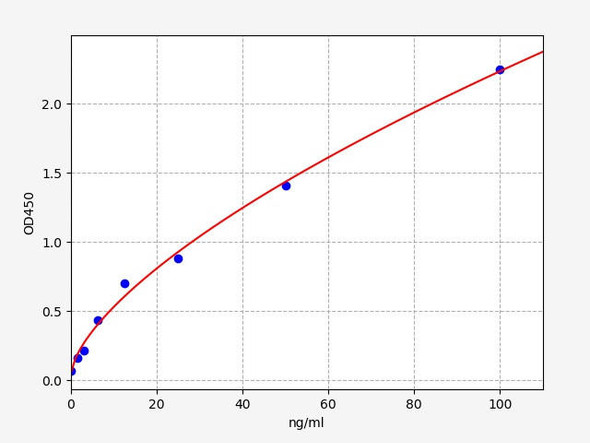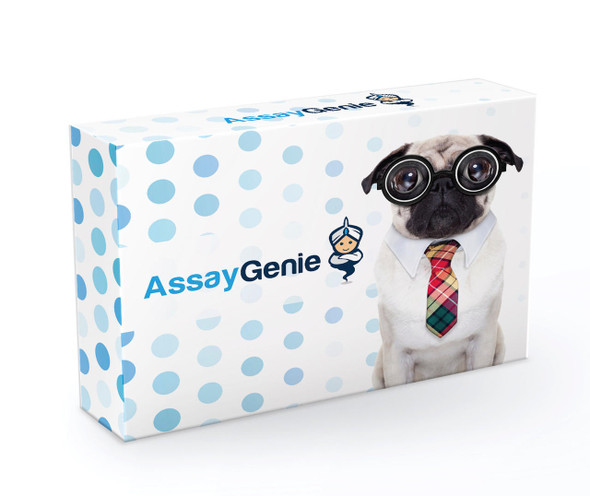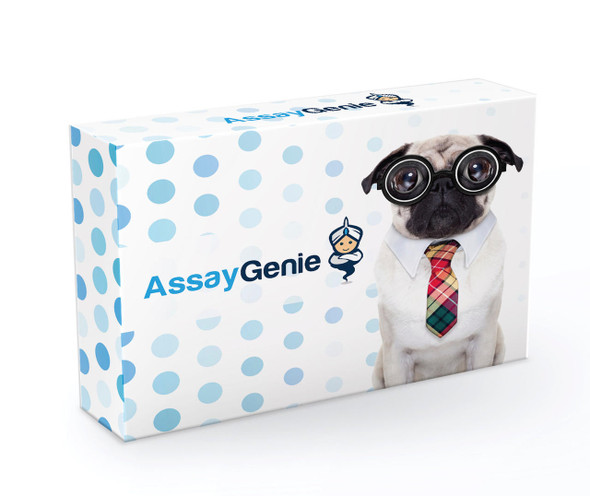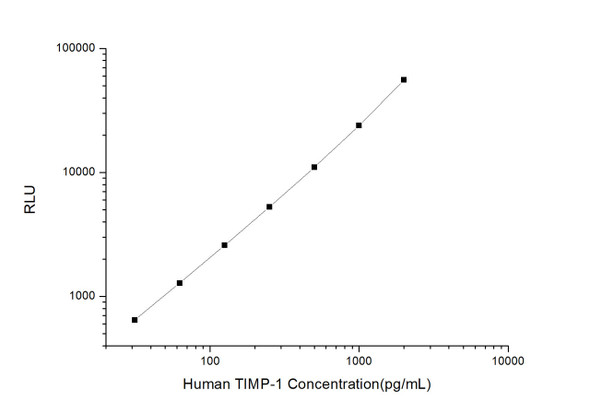Human Immunology ELISA Kits 1
Human TIMP-1 (Tissue Inhibitors of Metalloproteinase 1) ELISA Kit (HUES01451)
- SKU:
- HUES01451
- Product Type:
- ELISA Kit
- Size:
- 96 Assays
- Uniprot:
- P01033
- Sensitivity:
- 0.09ng/mL
- Range:
- 0.16-10ng/mL
- ELISA Type:
- Sandwich
- Synonyms:
- TIMP1, CLGI, EPA, EPO, HCI
- Reactivity:
- Human
- Sample Type:
- Serum, plasma and other biological fluids
- Research Area:
- Immunology
Description
| Assay type: | Sandwich |
| Format: | 96T |
| Assay time: | 4.5h |
| Reactivity: | Human |
| Detection Method: | Colormetric |
| Detection Range: | 0.16-10 ng/mL |
| Sensitivity: | 0.10 ng/mL |
| Sample Volume Required Per Well: | 100µL |
| Sample Type: | Serum, plasma and other biological fluids |
| Specificity: | This kit recognizes Human TIMP-1 in samples. No significant cross-reactivity or interference between Human TIMP-1 and analogues was observed. |
This ELISA kit uses Sandwich-ELISA as the method. The micro ELISA plate provided in this kit has been pre-coated with an antibody specific to Human TIMP-1. Standards or samples are added to the appropriate micro ELISA plate wells and combined with the specific antibody. Then a biotinylated detection antibody specific for Human TIMP-1 and Avidin-Horseradish Peroxidase (HRP) conjugate are added to each micro plate well successively and incubated. Free components are washed away. The substrate solution is added to each well. Only those wells that contain Human TIMP-1, biotinylated detection antibody and Avidin-HRP conjugate will appear blue in color. The enzyme-substrate reaction is terminated by adding Stop Solution and the color turns yellow. The optical density (OD) is measured spectrophotometrically at a wavelength of 450 nm ± 2 nm. The OD value is proportional to the concentration of Human TIMP-1. The concentration of Human TIMP-1 in samples can be calculated by comparing the OD of the samples to the standard curve.
| UniProt Protein Function: | TIMP1: Complexes with metalloproteinases (such as collagenases) and irreversibly inactivates them by binding to their catalytic zinc cofactor. Also mediates erythropoiesis in vitro; but, unlike IL-3, it is species-specific, stimulating the growth and differentiation of only human and murine erythroid progenitors. Known to act on MMP-1, MMP-2, MMP-3, MMP-7, MMP-8, MMP-9, MMP-10, MMP-11, MMP-12, MMP-13 and MMP-16. Does not act on MMP-14. Belongs to the protease inhibitor I35 (TIMP) family. |
| UniProt Protein Details: | Protein type:Motility/polarity/chemotaxis; Secreted, signal peptide; Secreted Chromosomal Location of Human Ortholog: Xp11. 3-p11. 23 Cellular Component: extracellular space; proteinaceous extracellular matrix; extracellular region; basement membrane Molecular Function:metalloendopeptidase inhibitor activity; protein binding; growth factor activity; protease binding; metal ion binding; cytokine activity Biological Process: response to peptide hormone stimulus; platelet activation; extracellular matrix organization and biogenesis; negative regulation of metalloenzyme activity; response to hormone stimulus; negative regulation of membrane protein ectodomain proteolysis; extracellular matrix disassembly; platelet degranulation; response to cytokine stimulus; positive regulation of cell proliferation; blood coagulation; aging; negative regulation of apoptosis |
| NCBI Summary: | This gene belongs to the TIMP gene family. The proteins encoded by this gene family are natural inhibitors of the matrix metalloproteinases (MMPs), a group of peptidases involved in degradation of the extracellular matrix. In addition to its inhibitory role against most of the known MMPs, the encoded protein is able to promote cell proliferation in a wide range of cell types, and may also have an anti-apoptotic function. Transcription of this gene is highly inducible in response to many cytokines and hormones. In addition, the expression from some but not all inactive X chromosomes suggests that this gene inactivation is polymorphic in human females. This gene is located within intron 6 of the synapsin I gene and is transcribed in the opposite direction. [provided by RefSeq, Jul 2008] |
| UniProt Code: | P01033 |
| NCBI GenInfo Identifier: | 135850 |
| NCBI Gene ID: | 7076 |
| NCBI Accession: | P01033. 1 |
| UniProt Secondary Accession: | P01033,Q14252, Q9UCU1, |
| UniProt Related Accession: | P01033 |
| Molecular Weight: | 23,171 Da |
| NCBI Full Name: | Metalloproteinase inhibitor 1 |
| NCBI Synonym Full Names: | TIMP metallopeptidase inhibitor 1 |
| NCBI Official Symbol: | TIMP1 |
| NCBI Official Synonym Symbols: | EPA; EPO; HCI; CLGI; TIMP |
| NCBI Protein Information: | metalloproteinase inhibitor 1; TIMP-1; collagenase inhibitor; erythroid potentiating activity; erythroid-potentiating activity; fibroblast collagenase inhibitor; tissue inhibitor of metalloproteinases 1 |
| UniProt Protein Name: | Metalloproteinase inhibitor 1 |
| UniProt Synonym Protein Names: | Erythroid-potentiating activity; EPA; Fibroblast collagenase inhibitor; Collagenase inhibitor; Tissue inhibitor of metalloproteinases 1; TIMP-1 |
| Protein Family: | Metalloproteinase inhibitor |
| UniProt Gene Name: | TIMP1 |
| UniProt Entry Name: | TIMP1_HUMAN |
As the OD values of the standard curve may vary according to the conditions of the actual assay performance (e. g. operator, pipetting technique, washing technique or temperature effects), the operator should establish a standard curve for each test. Typical standard curve and data is provided below for reference only.
| Concentration (ng/mL) | O.D | Average | Corrected |
| 10 | 2.414 2.462 | 2.438 | 2.358 |
| 5 | 1.584 1.632 | 1.608 | 1.528 |
| 2.5 | 0.915 0.901 | 0.908 | 0.828 |
| 1.25 | 0.401 0.415 | 0.408 | 0.328 |
| 0.63 | 0.281 0.257 | 0.269 | 0.189 |
| 0.31 | 0.174 0.172 | 0.173 | 0.093 |
| 0.16 | 0.12 0.14 | 0.13 | 0.05 |
| 0 | 0.079 0.081 | 0.08 | -- |
Precision
Intra-assay Precision (Precision within an assay): 3 samples with low, mid range and high level Human TIMP-1 were tested 20 times on one plate, respectively.
Inter-assay Precision (Precision between assays): 3 samples with low, mid range and high level Human TIMP-1 were tested on 3 different plates, 20 replicates in each plate.
| Intra-assay Precision | Inter-assay Precision | |||||
| Sample | 1 | 2 | 3 | 1 | 2 | 3 |
| n | 20 | 20 | 20 | 20 | 20 | 20 |
| Mean (ng/mL) | 0.50 | 1.40 | 3.60 | 0.50 | 1.40 | 3.50 |
| Standard deviation | 0.03 | 0.07 | 0.11 | 0.03 | 0.06 | 0.11 |
| C V (%) | 6.00 | 5.00 | 3.06 | 6.00 | 4.29 | 3.14 |
Recovery
The recovery of Human TIMP-1 spiked at three different levels in samples throughout the range of the assay was evaluated in various matrices.
| Sample Type | Range (%) | Average Recovery (%) |
| Serum (n=5) | 93-107 | 99 |
| EDTA plasma (n=5) | 89-102 | 95 |
| Cell culture media (n=5) | 93-107 | 99 |
Linearity
Samples were spiked with high concentrations of Human TIMP-1 and diluted with Reference Standard & Sample Diluent to produce samples with values within the range of the assay.
| Serum (n=5) | EDTA plasma (n=5) | Cell culture media (n=5) | ||
| 1:2 | Range (%) | 85-100 | 99-113 | 86-98 |
| Average (%) | 92 | 106 | 92 | |
| 1:4 | Range (%) | 96-110 | 85-98 | 92-109 |
| Average (%) | 102 | 91 | 100 | |
| 1:8 | Range (%) | 98-113 | 86-100 | 91-108 |
| Average (%) | 105 | 92 | 98 | |
| 1:16 | Range (%) | 95-111 | 83-96 | 95-112 |
| Average (%) | 101 | 88 | 102 |
An unopened kit can be stored at 4°C for 1 month. If the kit is not used within 1 month, store the items separately according to the following conditions once the kit is received.
| Item | Specifications | Storage |
| Micro ELISA Plate(Dismountable) | 8 wells ×12 strips | -20°C, 6 months |
| Reference Standard | 2 vials | |
| Concentrated Biotinylated Detection Ab (100×) | 1 vial, 120 µL | |
| Concentrated HRP Conjugate (100×) | 1 vial, 120 µL | -20°C(shading light), 6 months |
| Reference Standard & Sample Diluent | 1 vial, 20 mL | 4°C, 6 months |
| Biotinylated Detection Ab Diluent | 1 vial, 14 mL | |
| HRP Conjugate Diluent | 1 vial, 14 mL | |
| Concentrated Wash Buffer (25×) | 1 vial, 30 mL | |
| Substrate Reagent | 1 vial, 10 mL | 4°C(shading light) |
| Stop Solution | 1 vial, 10 mL | 4°C |
| Plate Sealer | 5 pieces | |
| Product Description | 1 copy | |
| Certificate of Analysis | 1 copy |
- Set standard, test sample and control (zero) wells on the pre-coated plate and record theirpositions. It is recommended to measure each standard and sample in duplicate. Note: addall solutions to the bottom of the plate wells while avoiding contact with the well walls. Ensuresolutions do not foam when adding to the wells.
- Aliquot 100 µL of standard solutions into the standard wells.
- Add 100 µL of Sample / Standard dilution buffer into the control (zero) well.
- Add 100 µL of properly diluted sample (serum, plasma, tissue homogenates and otherbiological fluids) into test sample wells.
- Cover the plate with the sealer provided in the kit and incubate for 90 min at 37 °C.
- Aspirate the liquid from each well, do not wash. Immediately add 100 µL of BiotinylatedDetection Ab working solution to each well. Cover the plate with a plate seal and gently mix. Incubate for 1 hour at 37 °C.
- Aspirate or decant the solution from the plate and add 350 µL of wash buffer to each welland incubate for 1-2 minutes at room temperature. Aspirate the solution from each well andclap the plate on absorbent filter paper to dry. Repeat this process 3 times. Note: a microplatewasher can be used in this step and other wash steps.
- Add 100 µL of HRP Conjugate working solution to each well. Cover with a plate seal andincubate for 30 min at 37 °C.
- Aspirate or decant the solution from each well. Repeat the wash process for five times asconducted in step 7.
- Add 90 µL of Substrate Reagent to each well. Cover with a new plate seal and incubate forapproximately 15 min at 37 °C. Protect the plate from light. Note: the reaction time can beshortened or extended according to the actual color change, but not by more than 30min.
- Add 50 µL of Stop Solution to each well. Note: Adding the stop solution should be done inthe same order as the substrate solution.
- Determine the optical density (OD value) of each well immediately with a microplate readerset at 450 nm.






